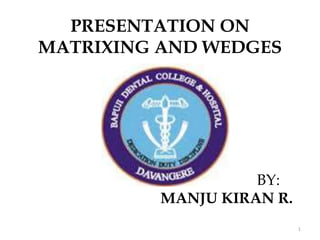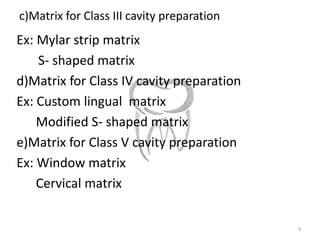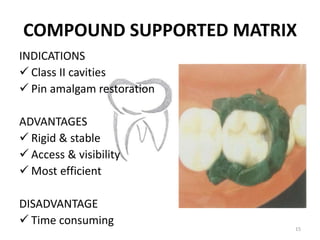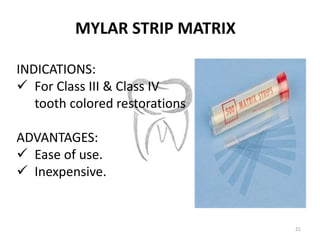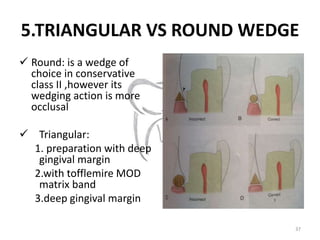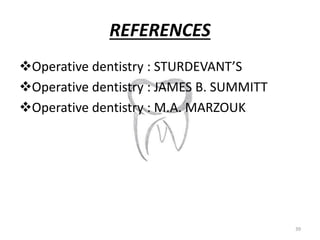Matrixing and wedges
- 1. PRESENTATION ON MATRIXING AND WEDGES BY: MANJU KIRAN R. 1
- 2. INTRODUCTION: MATRIX Appropriate axial tooth contours. Confine the restorative material excess. MATRIXING Temporary wall. WEDGES Device that create rapid separation. 2
- 3. OBJECTIVE: The matrix should : Displace the gingiva and rubber dam Provide shape for the restoration Confine the restorative material within the cavity 3
- 4. CONTACTS & CONTOUR Location of proximal contact area is normally Maxillary & mandibular anteriors : incisal third & positioned slightly facial Maxillary & mandibular posteriors :near the junction of occlusal and middle third or in the middle third 4
- 5. BENEFITS OF AN IDEAL CONTACT AND CONTOUR Health of periodontium Prevents food impaction Self cleansable Longevity of proximal restoration Normal mesio distal relationship 5
- 6. CLASSIFICATION: 1.Based on mode of retention: a) With retainer b) Without retainer 6
- 7. 2.Based on type of band a) Metallic non transparent b) Non metallic transparent 7
- 8. 3. Based on type of cavity for which it is used a) Matrix for Class I cavity preparation Ex: Double banded tofflemire b) Matrix for Class II cavity preparation Ex: Single banded tofflemire Ivory No. 1 Ivory No. 8 Copper band Anatomical Matrix Automatrix 8
- 9. c)Matrix for Class III cavity preparation Ex: Mylar strip matrix S- shaped matrix d)Matrix for Class IV cavity preparation Ex: Custom lingual matrix Modified S- shaped matrix e)Matrix for Class V cavity preparation Ex: Window matrix Cervical matrix 9
- 10. 4. Based on its preparation 1. Custom made or anatomic Ex: compound supported matrix 2. Mechanical matrix Ex: tofflemire, ivory no.1 & 8 matrices 10
- 11. IVORY NO.1 MATRIX An adjustable metal retainer, holds bands of stainless steel that provide the missing wall for the single proximal surface restoration (MO or DO). In middle of band one margin is slightly projected, which is kept toward the gingiva on the cavity side. Free end of matrix band are kept on the non cavity side. 11
- 12. IVORY NO.8 MATRIX Consists of a band that encircles the entire crown To restore class II cavities on one or both proximal surfaces of posterior tooth 12
- 13. UNIVERSAL MATRIX (Tofflemire Matrix) 13
- 14. INDICATIONS: Class I cavity with buccal/lingual extension b) Class II cavities ADVANTAGES: Ease of use. Good contact & contour Rigid & stable DISADVANTAGES: Does not produce optimum contact & contour for posterior composite Not useful for extensive class II 14
- 15. COMPOUND SUPPORTED MATRIX INDICATIONS Class II cavities Pin amalgam restoration ADVANTAGES Rigid & stable Access & visibility Most efficient DISADVANTAGE Time consuming 15
- 16. T BAND MATRIX INDICATIONS Class II cavities ADVANTAGES Simple , inexpensive Rapid and easy DISADVANTAGES Flimsy in structure, not stable 16
- 17. COPPER BAND MATRIX INDICATIONS Badly broken teeth, that receiving pin amalgam restorations class II with large buccal or lingual extensions ADVANTAGES Excellent contour DISADVANTAGES Time consuming 17
- 18. S SHAPED MATRIX INDICATIONS Class III restorations on canine Class II slot restorations ADVANTAGES Ideal contour on distal surface DISADVANTAGES Difficulty to apply 18
- 19. CERVICAL MATRICES INDICATIONS Class V restorations ADVANTAGES Good contour DISADVANTAGES Expensive 19
- 20. SECTIONAL MATRIX Sectional matrix system that delivers easy, predictable and accurate contact creation by utilizing advanced ring, matrix and wedge technology. It offers accurate contacts and tight marginal seal, minimized overhang and finishing, easy placement and removal. Ex: palodent ,garrison , dentsply 20
- 21. MYLAR STRIP MATRIX INDICATIONS: For Class III & Class IV tooth colored restorations ADVANTAGES: Ease of use. Inexpensive. 21
- 22. APPLICATION: Shaping the matrix. Preparing the retainer to receive the band. Placing the band with retainer on the prepared tooth. Removal of the band with the retainer. 22
- 23. WEDGES 23
- 24. Wedges are small, tapering, triangular pieces of, wood or clear plastic about ½ inch in length 24
- 26. WEDGE PRINCIPLE Mechanical method of tooth separation where a wedge or conical shaped device is inserted between adjacent teeth beneath the contact area of teeth which leads to separation. 26
- 28. SIZE & SHAPE SIZE:- ½ inches(1.2cm) Wedges are available in various sizes, which may be color coded. They are either plain (straight) or anatomically (triangular)shaped 28
- 29. 29
- 31. POSITION & PLACEMENT As near to the gingival cavosurface margin as possible Not only stabilizing the matrix but more importantly it is placed below gingival cavosurface margin to prevent amalgam from flowing below the cavo surface margin. 31
- 32. CORRECT & INCORRECT WEDGE POSITION 32
- 33. WEDGING TCHNIQUES 1. Single wedge technique 33
- 34. 2. PIGGY BACK WEDGING Useful for the patients with gingival recession Wedge is significantly apical of the gingival margin a second wedge may be placed on top of the first 34
- 35. 3.DOUBLE WEDGING One from lingual embrasure and one from facial embrasure Only if middle 2/3 of proximal margin can be adequately wedged. When proximal box is wide facio lingually 35
- 36. 4.WEDGE WEDGING Mostly employed on mesial aspect of maxillary I premolar, because of fluted roots(concavity) Second pointed wedge is inserted between the first wedge and the band, to wedge a matrix band tightly in such a margin 36
- 37. 5.TRIANGULAR VS ROUND WEDGE Round: is a wedge of choice in conservative class II ,however its wedging action is more occlusal Triangular: 1. preparation with deep gingival margin 2.with tofflemire MOD matrix band 3.deep gingival margin 37
- 38. 6.MODIFIED TRIANGULAR WEDGE (anatomic wedge) Modified to conform to the approximating tooth contours Prevents distortion of matrix contour Preferred for deeply extended gingival margins 38
- 39. REFERENCES Operative dentistry : STURDEVANT’S Operative dentistry : JAMES B. SUMMITT Operative dentistry : M.A. MARZOUK 39
- 40. 40
